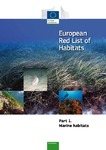European Red List of Habitats Part 1. Marine habitats
| dc.contributor.author | Gubbay, S | |
| dc.contributor.author | Hall-Spencer, Jason | |
| dc.contributor.other | European Union | |
| dc.date.accessioned | 2017-02-10T13:01:06Z | |
| dc.date.available | 2017-02-10T13:01:06Z | |
| dc.date.issued | 2016 | |
| dc.identifier.isbn | 978-92-79-61586-3 | |
| dc.identifier.uri | http://hdl.handle.net/10026.1/8448 | |
| dc.description.abstract |
The European Red List of Habitats provides an overview of the risk of collapse (degree of endangerment) of marine, terrestrial and freshwater habitats in the European Union (EU28) and adjacent regions (EU28+), based on a consistent set of categories and criteria, and detailed data and expert knowledge from involved countries1. A total of 257 benthic marine habitat types were assessed. In total, 19% (EU28) and 18% (EU28+) of the evaluated habitats were assessed as threatened in categories Critically Endangered, Endangered and Vulnerable. An additional 12% were Near Threatened in the EU28 and 11% in the EU28+. These figures are approximately doubled if Data Deficient habitats are excluded. The percentage of threatened habitat types differs across the regional seas. The highest proportion of threatened habitats in the EU28 was found in the Mediterranean Sea (32%), followed by the North-East Atlantic (23%), the Black Sea (13%) and then the Baltic Sea (8%). There was a similar pattern in the EU28+. The most frequently cited pressures and threats were similar across the four regional seas: pollution (eutrophication), biological resource use other than agriculture or forestry (mainly fishing but also aquaculture), natural system modifications (e.g. dredging and sea defence works), urbanisation and climate change. Even for habitats where the assessment outcome was Data Deficient, the Red List assessment process has resulted in the compilation of a substantial body of useful information to support the conservation of marine habitats. | |
| dc.format.extent | 1-52 | |
| dc.language.iso | en | |
| dc.publisher | Publications Office of the European Union | |
| dc.subject | marine conservation | |
| dc.title | European Red List of Habitats Part 1. Marine habitats | |
| dc.type | report | |
| plymouth.confidential | false | |
| plymouth.publisher-url | http://ec.europa.eu/environment/nature/knowledge/pdf/Marine_EU_red_list_report.pdf | |
| dc.identifier.doi | 10.2779/032638 | |
| plymouth.organisational-group | /Plymouth | |
| plymouth.organisational-group | /Plymouth/Faculty of Science and Engineering | |
| plymouth.organisational-group | /Plymouth/PRIMaRE Publications | |
| plymouth.organisational-group | /Plymouth/REF 2021 Researchers by UoA | |
| plymouth.organisational-group | /Plymouth/REF 2021 Researchers by UoA/UoA07 Earth Systems and Environmental Sciences | |
| plymouth.organisational-group | /Plymouth/Research Groups | |
| plymouth.organisational-group | /Plymouth/Research Groups/Marine Institute | |
| plymouth.organisational-group | /Plymouth/Users by role | |
| plymouth.organisational-group | /Plymouth/Users by role/Academics | |
| dc.publisher.place | Printed in England | |
| dc.rights.embargoperiod | Not known | |
| rioxxterms.versionofrecord | 10.2779/032638 | |
| rioxxterms.licenseref.uri | http://www.rioxx.net/licenses/all-rights-reserved | |
| rioxxterms.type | Technical Report | |
| plymouth.oa-location | http://ec.europa.eu/environment/nature/knowledge/pdf/Marine_EU_red_list_report.pdf |


